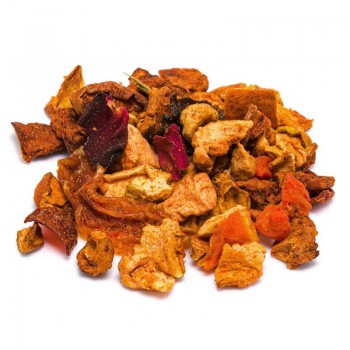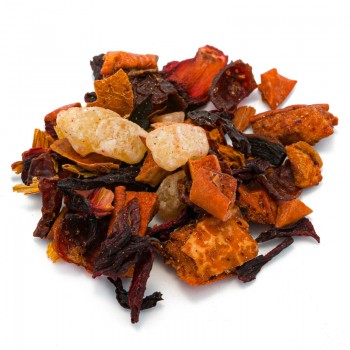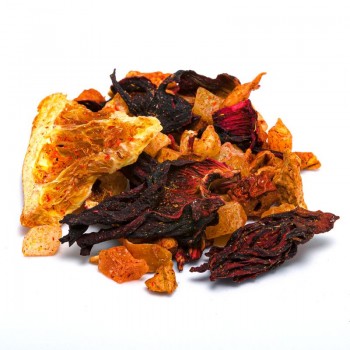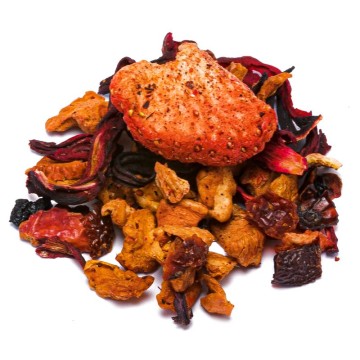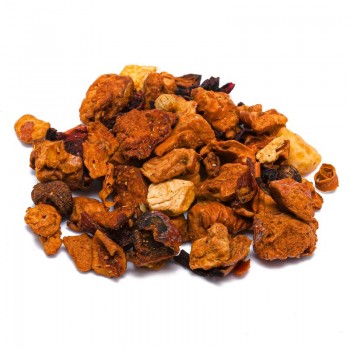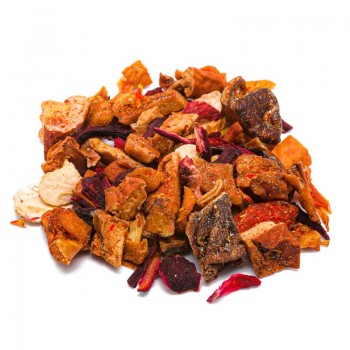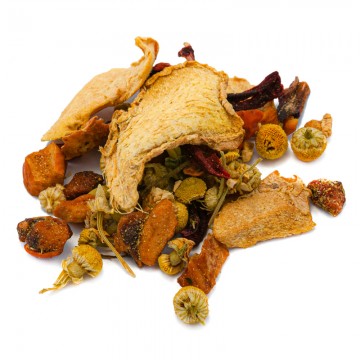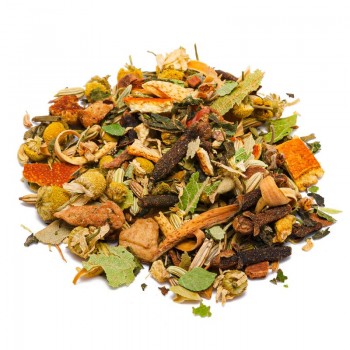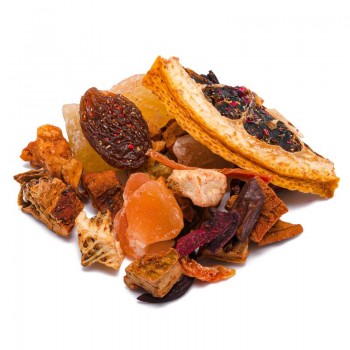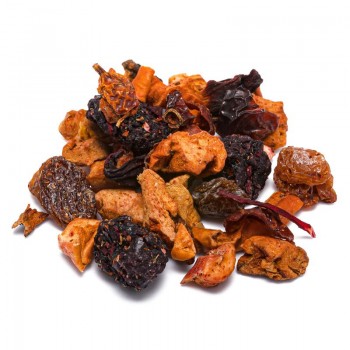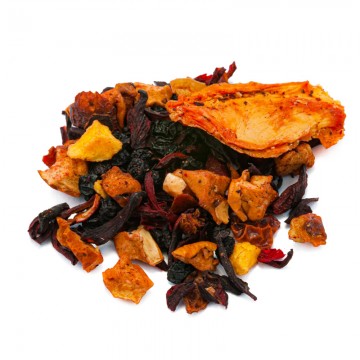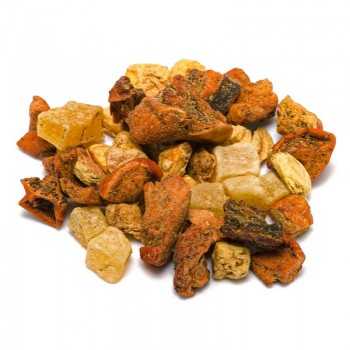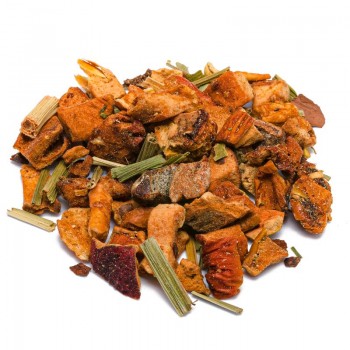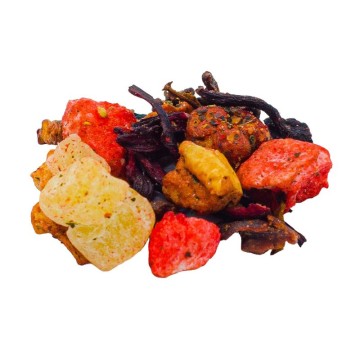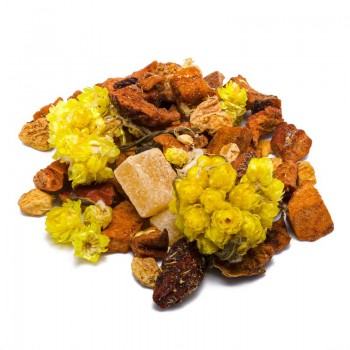Enjoy our almond and orange infusion - a fruity and spicy blend with pink pepper, cinnamon, sweet notes of cocoa, apple and the floral touch of safflower flowers. The elements balance each other, in their contrasts they are complementary: the blend creates a light infusion, which combines the fruity and citrus aroma of oranges with the sweetness of almonds. The delight of this combination arrives on the palate as pleasant and full of nuances. It is refreshing and perfect for promoting hydration and satisfying the search for a particular flavour. The drink can be served both hot and cold.
Orange and almond infusion: properties and benefits
By taking this infusion, its digestive capacity is made available to our body. It helps intestinal transit and favors the detox effect, stimulating diuresis and the body's metabolic activity. In the event of an imbalance in the bacterial flora, the orange and almond components in the infusion introduce beneficial bacteria and soothe intestinal irritations. These functions are also adequate in case of constipation, they allow to calm abdominal swelling and act as light natural laxatives. Other elements of the infusion such as apple, cocoa and cinnamon also promote the well-being of the stomach and soothe nausea after a heavy meal. Pink pepper is also a useful element to stimulate the assimilation of foods. Thanks also to other antioxidants, tea with orange and almond helps to increase the probiotic bacteria in the intestines, which favor our immune system. Almonds represent, among dried fruit, nuts rich in precious beneficial substances. They release minerals (magnesium, manganese, zinc) and vitamins (C, group B), giving the infusion a savory taste. The orange makes available vitamin C (also present in safflower) and vitamin A, essential for the correct functioning of the immune system and excellent antioxidants.
Origins and History of cultivation
The herbal tea blend has natural elements that help the well-being of the digestive system. To create this infusion, the following have been used: apple, cocoa, almonds, orange, cinnamon, pink pepper, safflower flowers. Among the main foods, the orange is known since ancient times as an exquisite and beneficial citrus fruit. The origin is uncertain but the most cultivated version is the sweet orange, and widespread in many parts of the world - given that the plant easily adapts to variable environmental conditions. It is probably a hybrid plant derived from the bitter orange, or a cross between the pomelo and the mandarin - given that the presence of oranges has been attested for centuries in China. The sweet orange tree is thought to have originated here over 4,000 years ago. Through trade he reached Asia Minor from here, then Egypt, North Africa and finally Europe.
It was a fruit symbol of love and fertility; orange blossoms are a good omen for marriage. In Italy, during the Renaissance, the cultivation of the sweet orange began in the regions of Sicily and Calabria, introduced by the Portuguese - in many dialects, in fact, the orange was called "Portugal". This blend offers a second important ingredient, the almond. Appreciated by civilizations all over the world, it was already widespread in the Mediterranean area thousands of years ago. Almonds were mentioned in the Bible, Greek mythology and ancient medical texts as beneficial foods. They became a symbol of good luck for fertility in ancient Rome, where the spouses were sprinkled with almonds (almond sugared almonds continue the tradition).
To date, the almond is a dried fruit widespread throughout the world, with numerous cultivated varieties. In oriental cuisine they are used to give flavor to meat, fish and vegetable main courses. Almonds are eaten raw, roasted or blanched, and are particularly used in confectionery.
Plants and flowers
The components of the infusion are many, with fruits and flowers from different sources. Almond seeds derive from the Prunus dulcis almond tree, of the Rosaceae family. Originally from Asia, it is grown mainly in Mediterranean climates and in California. The plant reaches a height of up to 3-4 meters, and is famous for its beautiful light pink or white flowers. The fruit is a drupe that looks like a peach; when it matures, the outer covering opens and the stone comes out. Almonds are not real nuts, but seeds enclosed in a hard fruit.
The seeds of the sweet almond (Prunus dulcis variety dulcis) are the edible ones, consumed as fruitecca in the kitchen, or as a source of oil or almond flour. The tree that gives the oranges is the orange Citrus sinensis L. belonging to the Rutaceae family. Sweet oranges, fruits of this variety, are distinguished from bitter oranges. Citrus sinensis can reach 12 meters, with elongated leaves and white flowers. The fruits are round and orange with a rough skin, and the harvest often gives abundant fruit.
Over the centuries, many varieties of orange have developed, which is now a widespread citrus fruit all over the world. There are varieties of table oranges, for juice, for the production of juices, candied fruit and dried oranges.
The Malus domestica of the Rosaceae family is the plant that gives us apples. The tree is native to Asia, now spread all over the planet. The fruits differ in colors and in many varieties, and have been used in human nutrition for thousands of years. Pink pepper is obtained from the berries of a South American shrub, the Schinus molle. The fruit shows the characteristic pink color and a shape similar to a peppercorn (this is why it is called pink pepper or false pepper).
It gives the palate a soft texture and a different flavor from pepper, more delicate and sweet.
Cocoa derives from the evergreen tropical plant of the Theobroma cacao genus, belonging to the Malvaceae family. Originally from the South American rainforests, it grows naturally in the equatorial territory, with a hot and very humid climate. After four years the cocoa tree produces fruit, elongated pods. Each contains 20 to 60 oval seeds, covered with a sweet, sticky white pulp. The seeds, also called cocoa beans, are transformed into cocoa butter, cocoa powder and chocolate.
The name of the cinnamon tree is Cinnamomum zeylanicum and comes from Ceylon (Sri Lanka). It is an evergreen tree of the Lauraceae family, growing up to 15 meters. From the dried inner bark, the cinnamon spice is obtained, known for its aromatic properties. The spice can also be made from species related to Ceylon cinnamon, including Chinese cassia (Cinnamomum cassia), Vietnamese cinnamon (C. loureiroi), Indonesian cinnamon (C. burmannii), and Malabar cinnamon (C. citriodorum).
Safflower flowers derive from Carthamus tinctorius, an annual herbaceous plant of the Asteraceae family. It is highly branched and looks similar to a thistle, 30 to 150 cm tall and displays yellow, orange or red flowers. It was born in arid environments, where it survives thanks to its deep roots. It was used in ancient times as a substitute for saffron, and is still cultivated today to obtain the vegetable oil extracted from the seeds.
Nutritional values of orange and almond infusion
The ingredients make vitamins (A, C, group B9, and mineral salts such as potassium, iron, magnesium, zinc, manganese and copper) available in the infusion. How to use the ingredients in the infusion
The infusion is obtained by placing about 3-5 grams of the orange and almond mixture in a cup (250 ml) with water at 100 °C. to 12 minutes, before drinking.Add honey or sugar, if desired.
Orange and almond infusion: side effects and contraindications
Even if the infusion brings benefits, it is necessary not to exceed the doses, nor to take it continuously for too long periods. Excessive intake can cause nausea, headache, diarrhea and abdominal swelling. The almond element should be considered in its potential allergic effects, as well as for the other ingredients. Anyone who shows allergic reactions to nuts and dried fruit should be careful with almonds. They could cause side effects such as mouth swelling, wheezing and skin rashes. Caution is advised for pregnant and breastfeeding women.

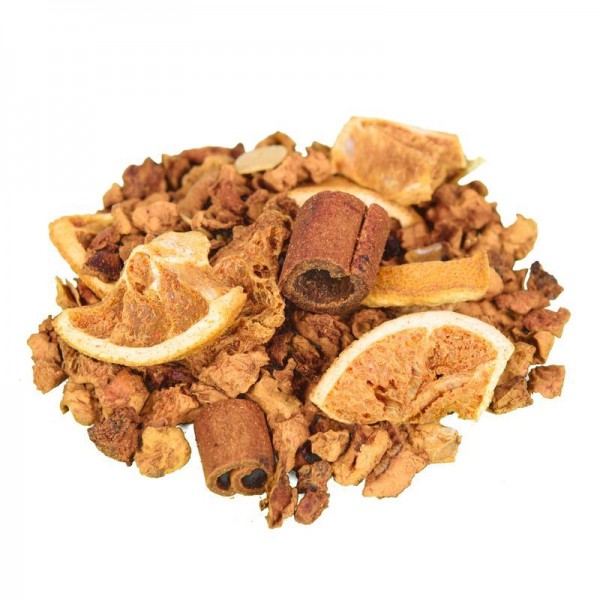









 No reward points for this product.
No reward points for this product.
